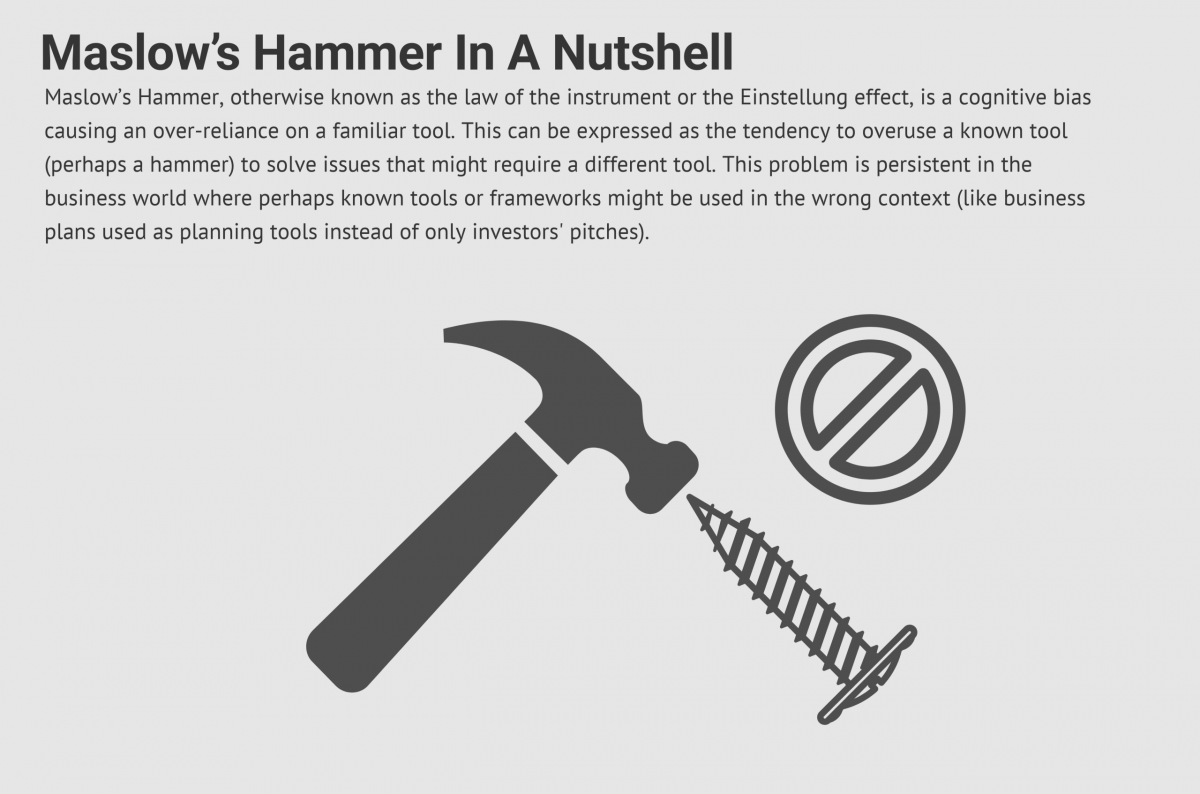Introduction
In the realm of decision-making, it is easy to fall into the trap of relying solely on familiar tools or solutions without critically evaluating their suitability for the task at hand. Maslow’s Hammer, also known as the law of the instrument, warns against this tendency and highlights the importance of using the right tool for each situation. This mental model, deeply rooted in human psychology, influences our day-to-day lives and decision-making processes. In this blog post, we will explore the concept of Maslow’s Hammer, its relevance in decision-making, examples of its occurrence in personal life, business scenarios, and public policy-making. We will also delve into the underlying biases that contribute to this fallacy and provide practical strategies to identify and overcome it for more objective decision-making.
Understanding Maslow’s Hammer
Maslow’s Hammer can be defined as the cognitive bias that leads individuals or groups to rely excessively on familiar tools or methods, even when they may not be the most effective or appropriate solution for a given situation. The name is derived from the famous saying, “If all you have is a hammer, everything looks like a nail.” This mental model reminds us that having a narrow range of tools can limit our problem-solving abilities and hinder optimal decision-making.
Relevance in Decision-Making
Maslow’s Hammer is highly relevant in decision-making processes, as it cautions against the tendency to favor familiar or comfortable approaches without considering alternative perspectives or solutions. It highlights the importance of consciously evaluating the suitability and effectiveness of different tools or methods to achieve desired outcomes.
Anchored in Human Psychology
Maslow’s Hammer finds its roots in several psychological biases and cognitive tendencies that shape our thinking:
- Confirmation Bias: This bias leads us to seek and favor information that confirms our existing beliefs or preconceived notions. When we have a favored tool or approach, we tend to look for evidence that supports its effectiveness while overlooking contradictory evidence.
- Availability Heuristic: Our minds often rely on readily available information to make judgments and decisions. If we are accustomed to a specific tool, it becomes the most accessible option in our mental toolkit, leading us to overlook other potentially better-suited alternatives.
- Cognitive Ease: The human brain is wired to seek cognitive ease, preferring familiarity and the path of least resistance. Familiar tools or methods provide a sense of comfort and familiarity, reducing cognitive effort and the need for critical evaluation.
Examples of Maslow’s Hammer in Various Contexts
- Personal Life Decisions: Imagine a person who has always relied on dieting as the primary method for weight management. Despite emerging research suggesting the benefits of a holistic approach combining exercise, nutrition, and mental well-being, this individual continues to exclusively focus on dieting. By stubbornly clinging to their familiar tool (dieting), they may miss out on a more comprehensive and effective approach to improving their health.
- Business Scenarios: In business, companies often find themselves relying on outdated or inefficient technologies simply because they have invested heavily in them or are accustomed to using them. For example, a company might persist in using outdated software systems, even when newer, more efficient solutions are available. This overreliance on familiar tools can hinder progress, productivity, and competitiveness.
- Public Policy-Making: In public policy, Maslow’s Hammer can manifest when decision-makers repeatedly implement the same approaches to address complex societal issues. They may overlook innovative solutions or fail to adapt to changing circumstances. For instance, a government may continue investing in traditional infrastructure projects instead of exploring more sustainable and environmentally friendly alternatives.
Understanding the Psychological Underpinnings
Maslow’s Hammer is influenced by various cognitive biases and fallacies:
- Anchoring Bias: This bias refers to our tendency to rely heavily on the first piece of information encountered when making decisions. If we have been exposed to a particular tool or method early on, it becomes an anchor that shapes our subsequent judgments and choices.
- Status Quo Bias: Our inclination to prefer the existing state of affairs can reinforce the reliance on familiar tools. The desire to maintain the status quo can overshadow the potential benefits of exploring alternative approaches.
Avoiding the Maslow’s Hammer Pitfall
Identifying when we might be succumbing to Maslow’s Hammer is crucial for effective decision-making. Here are strategies to help us avoid this cognitive trap
- Foster a Growth Mindset: Embrace a mindset that encourages continuous learning, exploration, and adaptation. Recognize that relying solely on familiar tools limits growth and progress.
- Embrace Diversity of Perspectives: Actively seek out diverse viewpoints and perspectives when making decisions. Engage with individuals who can offer alternative tools or methods to broaden your problem-solving repertoire.
- Encourage Experimentation: Create an environment that encourages experimentation and risk-taking. Provide space for exploring new tools or approaches, even if they may initially feel unfamiliar or uncomfortable.
- Challenge Confirmation Bias: Be aware of your inclination to seek information that confirms your existing beliefs. Actively seek out contradictory evidence and challenge your assumptions to ensure a balanced evaluation of different tools or methods.
Conclusion
Maslow’s Hammer serves as a reminder to critically evaluate the tools and methods we use in decision-making. By recognizing the prevalence of this fallacy in our day-to-day lives and understanding the underlying psychological biases, we can navigate the complexity of decision-making more effectively. By embracing diversity of perspectives, encouraging experimentation, and challenging confirmation bias, we can broaden our problem-solving capabilities and make more informed decisions. Awareness and active avoidance of Maslow’s Hammer can lead to more adaptive, innovative, and successful outcomes across various domains. Let us remember that the right tool for the job may not always be the one we are most familiar with, and by expanding our toolkit, we unlock new possibilities for growth and progress.
